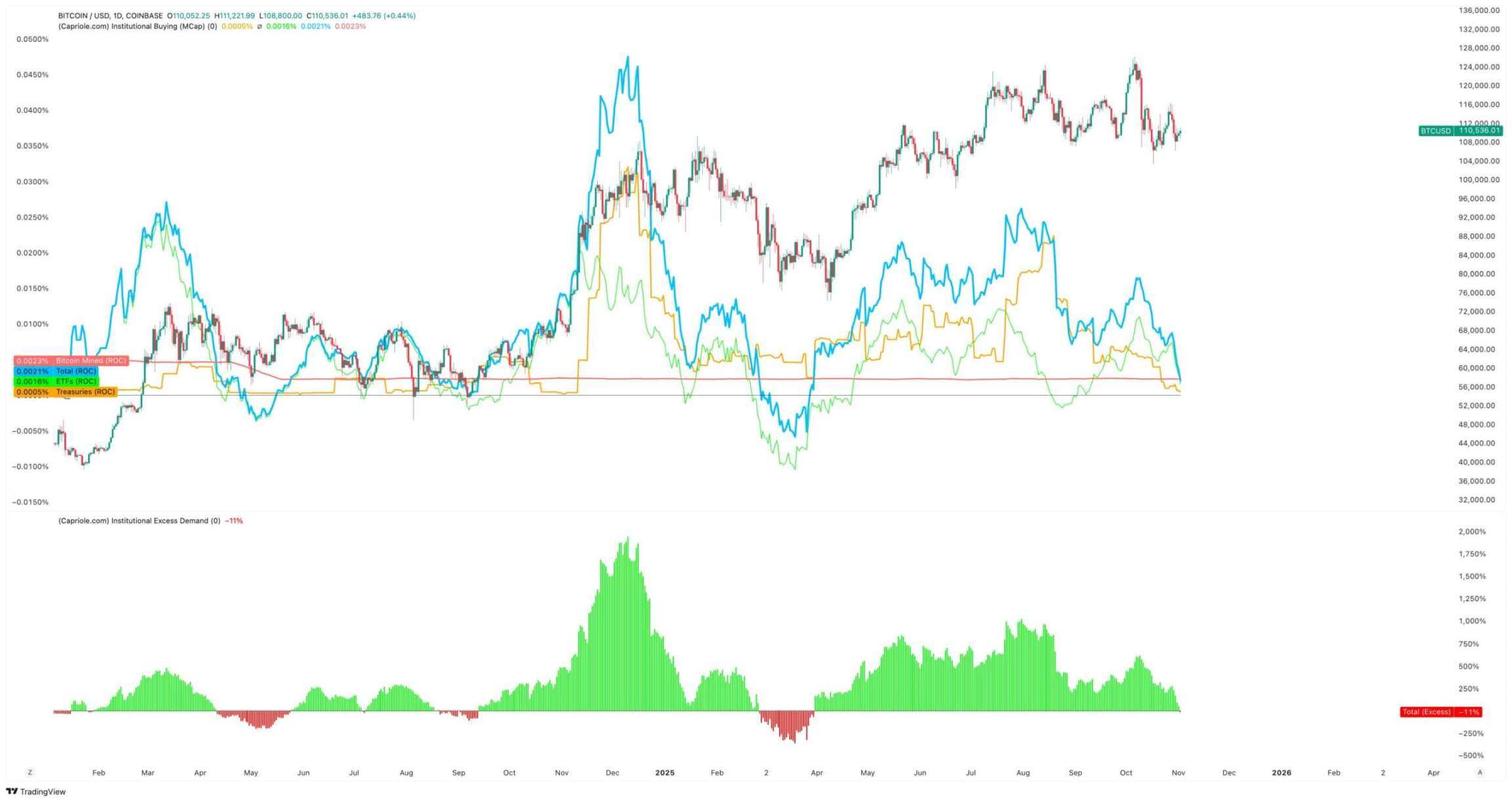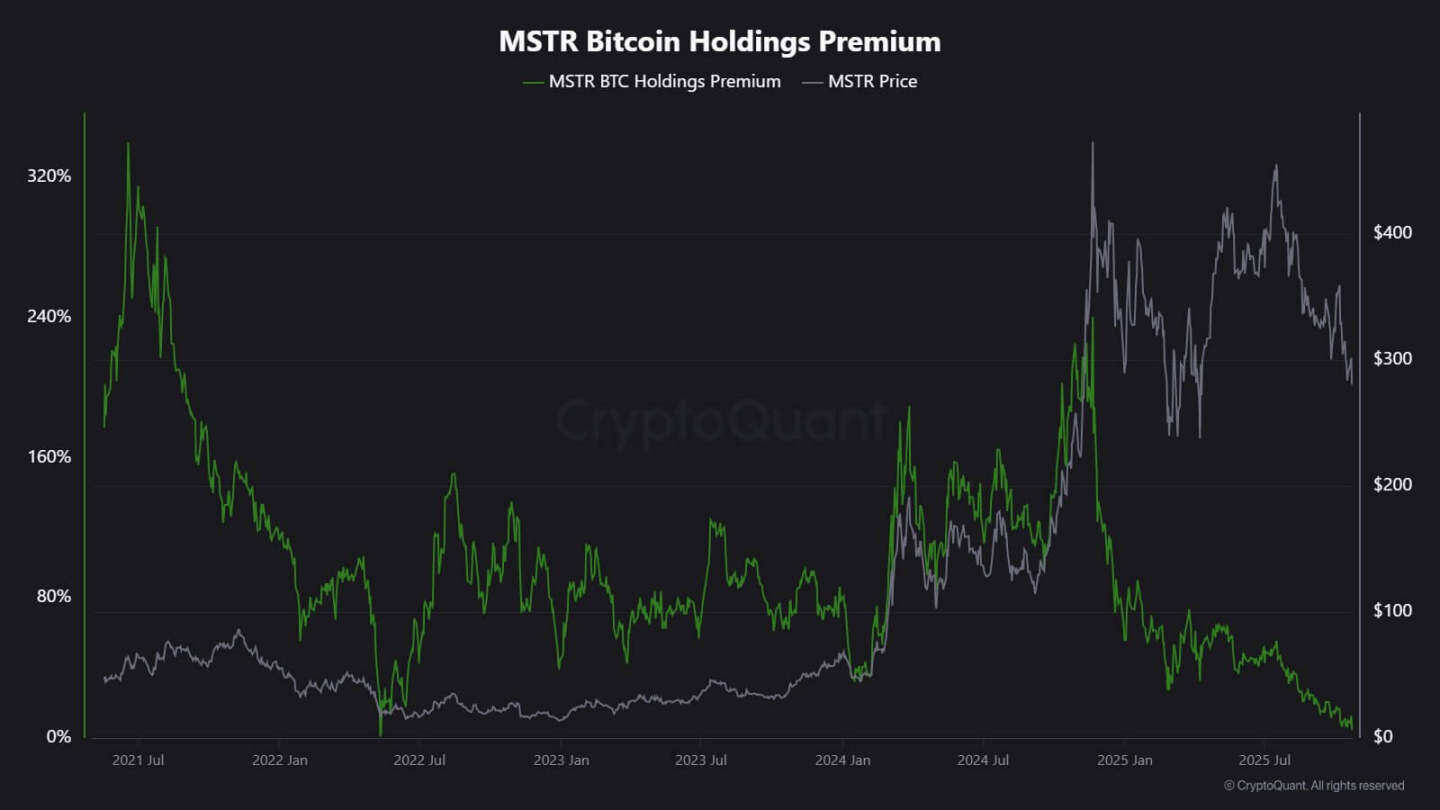Giants halt their buying, ETFs cool down: What's the real reason behind Bitcoin's recent decline?
- 核心观点:比特币机构购买力显著减弱。
- 关键要素:
- 企业比特币财库增持大幅放缓。
- 比特币ETF资金流入转为波动。
- 机构净买入量跌破挖矿供应。
- 市场影响:价格波动加剧,依赖宏观情绪。
- 时效性标注:短期影响
Original title: Why is Bitcoin's largest buyer no longer "shopping spree"?
Original author: Oluwapelumi Adejumo
Original translation by Luffy, Foresight News
For most of 2025, Bitcoin's support level seemed unshakeable because the unexpected alliance between Enterprise Digital Assets (DAT) and Exchange Traded Funds (ETFs) formed the basis of this support.
Corporate purchases of Bitcoin through the issuance of stocks and convertible bonds, while ETF inflows quietly absorb new supply. Together, these factors have created a solid demand base, helping Bitcoin withstand the pressure of tightening financial conditions.
Now, this foundation is beginning to crumble.
On November 3, Charles Edwards, founder of Capriole Investments, posted on the X platform that his bullish expectations have weakened as institutional buying has slowed.
He pointed out: "For the first time in seven months, institutional net buying has fallen below the daily mining supply, which is a bad sign."

Bitcoin institutional buying volume, source: Capriole Investments
Edwards stated that even though other assets outperform Bitcoin, this metric remains a key reason for his optimism.
However, as things stand, approximately 188 companies hold substantial Bitcoin positions, many of which have relatively simple business models besides their Bitcoin exposure.
Bitcoin treasury holdings slow down
No company is more representative of corporate Bitcoin trading than MicroStrategy, which recently changed its name to "Strategy".
This software maker, led by Michael Saylor, has transformed into a Bitcoin treasury company and currently holds over 674,000 Bitcoins, making it the world's largest single corporate holder.
However, its buying pace has slowed significantly in recent months.
Strategy added only about 43,000 Bitcoins in the third quarter, its lowest quarterly purchase volume this year. This figure is not surprising, considering that some of the company's Bitcoin purchases during this period plummeted to just a few hundred.
CryptoQuant analyst JA Maarturn explained that the slowdown in buying may be related to the decline in Strategy's net asset value (NAV).
He stated that investors had previously paid a high "NAV premium" for every $1 of Bitcoin on Strategy's balance sheet, effectively allowing shareholders to share in the gains from Bitcoin's rise through leveraged exposure. However, this premium has narrowed significantly since the middle of the year.
With the valuation advantage diminishing, purchasing Bitcoin through issuing new shares no longer yields significant value appreciation, and the incentive for companies to raise funds to increase their holdings has also decreased.
Maarturn noted, " Funding has become more difficult, and the stock issuance premium has fallen from 208% to 4%. "

Strategy stock premium, source: CryptoQuant
At the same time, the trend of cooling down the holdings is not limited to Strategy.
Tokyo-listed Metaplanet once followed the model of this American pioneer, but its stock price has recently fallen sharply and is trading below the market value of its Bitcoin holdings.
In response, the company approved a share buyback program and introduced new financing guidelines to expand its Bitcoin Treasury. This move demonstrates the company's confidence in its balance sheet, but also highlights waning investor enthusiasm for the "crypto treasury" business model.
In fact, the slowdown in the growth of Bitcoin assets has led to some corporate mergers.
Last month, asset management firm Strive announced its acquisition of Semler Scientific, a smaller Bitcoin asset holding company. The combined entity will hold nearly 11,000 Bitcoins.
These cases reflect structural constraints, not a wavering of belief. When stock or convertible bond issuances no longer command a market premium, capital inflows dry up, and corporate acquisitions naturally slow down.
What are the fund flows like in ETFs?
The spot Bitcoin ETF, which has long been regarded as an "automatic absorber of new supply," has also shown similar signs of weakness.
For most of 2025, these financial investment instruments dominated net demand, with subscriptions consistently exceeding redemptions, especially during Bitcoin's surge to all-time highs.
However, by late October, its fund flows became volatile. Influenced by changes in interest rate expectations, portfolio managers adjusted positions, risk departments reduced exposure, and some weekly fund flows turned negative. This volatility marks a new phase in the behavior of Bitcoin ETFs.
The macroeconomic environment has tightened, hopes for rapid interest rate cuts have faded, and liquidity conditions have cooled. Nevertheless, market demand for Bitcoin exposure remains strong, but has shifted from "steady inflows" to "pulsating inflows."
SoSoValue's data vividly illustrates this shift. In the first two weeks of October, crypto asset investment products attracted nearly $6 billion in inflows; however, by the end of the month, some of these inflows were wiped out as redemptions increased to over $2 billion.

Bitcoin ETF weekly fund flows, source: SoSoValue
This model demonstrates that Bitcoin ETFs have matured into a truly two-way market. They still offer deep liquidity and institutional access, but are no longer a one-way tool for increasing holdings.
When macroeconomic signals fluctuate, ETF investors may exit as quickly as they enter the market.
Market impact on Bitcoin
This shift doesn't necessarily mean a Bitcoin price drop, but it does foreshadow increased volatility. As corporate and ETF absorption capacity weakens, Bitcoin's price movements will become increasingly driven by short-term traders and macro sentiment.
Edwards believes that in this scenario, new catalysts—such as monetary easing, regulatory clarity, or a return to risk appetite in the stock market—could reignite institutional buying.
However, at present, marginal buyers are more cautious, making price discovery more sensitive to the global liquidity cycle.
The impact is mainly reflected in two aspects:
First, the structural buying that previously served as support levels is weakening. During periods of insufficient absorption, intraday volatility can intensify due to a lack of stable buyers to mitigate it. The halving in April 2024 will structurally reduce new supply, but scarcity alone cannot guarantee price increases without sustained demand.
Second, Bitcoin's correlation characteristics are shifting. As balance sheet buying cools down, the asset may once again fluctuate in tandem with the overall liquidity cycle. Periods of rising real interest rates and a stronger dollar may put downward pressure on prices, while a looser environment could allow it to regain its leading position during periods of improved risk appetite.
Essentially, Bitcoin is re-entering a macro-reflection phase, behaving more like a high-beta risk asset than digital gold.
At the same time, all of this does not negate the long-term narrative of Bitcoin as a scarce, programmable asset. On the contrary, it reflects the growing influence of institutional dynamics—the very institutions that once shielded Bitcoin from retail-driven volatility, and now, the very mechanisms that propelled Bitcoin into mainstream portfolios are making it more closely linked to capital markets.
The coming months will test whether Bitcoin can maintain its store-of-value properties in the absence of automatic inflows from businesses and ETFs.
Historically, Bitcoin has often demonstrated adaptability. When one channel of demand slows down, another emerges —perhaps from national reserves, fintech consolidation, or the return of retail investors during periods of macroeconomic easing.



